
Project 57b, 57A (1959-1993)
 8 conventional destroyers (1+ cancelled) built 1957-1960: Gremyashchy, Zhguchy, Zorky, Derzky, Gnevny, Uporny, Boyky, Gordy, Khrabry
8 conventional destroyers (1+ cancelled) built 1957-1960: Gremyashchy, Zhguchy, Zorky, Derzky, Gnevny, Uporny, Boyky, Gordy, Khrabry
Project 57, First Soviet Missile Destroyers
Project 57b destroyers (NATO Krupny) were derived from Project 56A ships (NATO Kotlin M), but equipped with missile launchers after conversion trials of Project 56M Kildin. They were among the first of this type in the world, later modified until 1958, when the first was launched. They were assentially enlarged Kotlin with NBC protection, with a twin anti-ship missile launcher, 12 KSShch (SS-N-1) and a permanent Kamov Ka-15 “Hen” observation helicopter, plus broadside triple ASW TTs.
As early as 1965, there were talk of modifying them into ASW, the “Kanin” conversions. In this new configuration they received axial quintuple TT banks (project 57), two ASM RBU 6000 ASWRL, one Ka-25PLO helicopter with three AT-1 acoustic torpedoes or up to 144 ASW PLAB grenades, 72 standard buoys, 30 radar and marker relays. Kanin class ships (future separate article) also had a SA-N-1 twin ramp (32) in place of their SS-N-1. These modifications extended to the propulsion with more powerful diesels, mofified hull for better acoustics (lengthened to 140 meters) and rising displacement to 3,700 standard, 4,500 FL tons. These were the first Soviet missile warships with a TTZ signed by Admiral Kuznetsov on 25 July 1955. Designed from the beginning as missile ships they designation changed as Project 57bis while still in development, rather than Project 53. “Project 57” may have been an alternative configuration. Work started by December 1956, until new navy commander Admiral Gorshkov, ordered changes in February 1957, this time to engage enemy surface ships and shore targets with the same weapon system.
These eight ‘Kanin’ (as knonw by NATO), formerly “Krupny” were launched in 1959-61 and completed in 1960-61, modified in 1956-67, still in service by 1987. This year, the first two were withdrawn from service, followed by two others. In 1988, the remaining four stayed active into 1990. That same year, one was discarded, followed by one in 1991 and the last two in 1993. They were an interesting step towards the more mature Kashins.
Development
The surface-to-surface anti-ship missile “Pike” (KSSH) (NATO – SS-N-1 Scrubber) originally developed in the late 40s was first intended to be launched from aircraft and coastal installation for shore defence. However it was later decided to use it aboard ships. The first use of such missiles were project 56 destroyers, Bedovyy class (NATO Kotlin). Initially, it was asked to place two KSShch launchers on board destroyer, but already at the initial stage of development on the experimental project 56-EM it became clear that this was impossible on the project 56 hull, too small.
Therefore, in parallel with the construction of Project 56-M destroyers (Kildin class), a decision by the Ministry of Ship Design and Commander-in-Chief of the Navy on July 26, 1955, was to launch the development of a new and dedicated ship tailored to operate two KSSH weapons systems. The project was assigned the number 57, as a revision of Project 56.
On January 23, 1956, the Central Design Bureau MSP (TsKB-53) presented technical requirements with two SM-59 launchers and 19 KSShch missiles in store. Howeve later in development it turned out that the seaworthiness of Project 57 (Krupny) would be low: Top speed decreased and for stability as 250 tons of ballast were added, and this evolved unto the improved Project 57B (or 57-bis).
Project 57-B (57-bis) Krupny class
The development of technical project number 57 bis was completed by December 30, 1956. The ship was intended mainly for the destruction of surface ships (cruisers, destroyers and large transports) and coastal objectives using the KSShch complex. The location of combat posts, weapons, machinery installations, mess and offices were almost completely retaken from Project 56 Kotlin.
The Power plant compared to Project 56 were that machines and boiler rooms were in better separated and well sealed rooms with permanent remote control posts. Also, the electrical power system was designed for the first time to run at 380 V, making it possible to increase diesel generators from 200 to 300 kW.
As for the Armament the centerpieces were the KSShch missile system (two SM-59-1A launchers, bow and stern). The main control system was the Topol radar, already used on project 57-bis (Kanin) and they provided salvo firing by both launchers, at a single target, sea or land, but allowed for separate firing at two targets. Intervals between launches for reload was 5-15 seconds.
Just like in Project 56, the placement of the four quadruple 57-mm ZIF-75 AA funs, coupled with two Fut-B fire control radars was in a rhombic pattern, fore and aft, two broadside. The backup artillery fire control system was the SVP-42-50 command and rangefinder post installed on the bow superstructure. The torpedo armament was strengthened, by installing two triple-tube banks instead of twin tubes banks. The ASWRL remained the same as for 56-M destroyers, two RBU-2500) but they were moved to the stern, behind the bow launcher SM-59-1A on either side.
Design
Hull and general design

Project 57A, Kanin class

Project 57bis Krupny class
These destroyers looked obviously larger and buffier than the Kotlins, with the same flush deck hull, well slanted, large bow in order to not plough in heavy weather. Due to the increased displacement and changes in superstructures, living conditions of rank and file and petty officers were improved. Unline on the Kotlins where the superstructures and ceilings were made of aluminum-magnesium alloy, steel was used on Project 57 ships, more robust, cheaper, and not flamable.
Powerplant

Project 57a Gnevny two views blueprint
Armament (Project 57 bis)
2x SM-59-1A ‘Pike’ launchers (NATO SS-N-1 Scrubber, GRAU 4K32)
In all, there were from 12 to 16 KSShch missiles, with the Topol launcher system and backup Kedr system to compensate for the lacking direct radar visibility.
Each of two KSShch missile magazines fore and aft had six vectors, with one exrta carried in the box launcher, another in the magazine. The Topol system had an improved computer compared to the Previous Project 56M, and a sighting and range-finding station as well as an auxiliary control system, Zalp-Shch radar. The new Rangout radar developed for it was never adopted. Using an auxiliary they were able to engage two targets simultaneously. It was also planned to install the Grusha television receiver system for target designation display coming from an aircraft beyond the horizon, but it lacked reliability. The Ka-15 helicopter could be used as such over the horizon data link for the missiles but this proved unsatisfactory in visual observation, making it too exposed. In the end, the idea was abandoned and photos rarely shows it.
These could be either conventionally or nuclear tipped.
Dimensions: 7.6 m (25 ft) x 900 mm (3 ft) diameter, Wingspan 4.6 m (15 ft)
Weight: 3,100 kg (6830 lb)
Warhead: nuclear warhead or High Explosive
Propulsion: liquid-fuel rocket, speed Mach 0.9, range 68 km (42 mi), Inertial guidance
Four 4-barreled 57-mm ZIF-75 AA
They were installed in a lozenge pattern, fore, aft and broadsides. Same type used on the export Skoriy, Kildin (Pr.56M) class and Krupny (Pr.57) classes. Improved model compared to the ZIF-71. Each barrel weighted 606.2 lbs. (275 kg) with a bore Length of 168.31 in (4.275 m) and practical rate of 100 rounds per minute. They used Tracer-FRAG (UOP-281 and 281U) charges of 0.37 lbs. (0.168 kg) and 0.34 lbs. (0.154 kg), and fired the 6.17 lbs. (2.8 kg) tracer FRAG as well as the HE round UFB-71, same weight. Max ballisitic range was 9,210 yards (8,420 m), max range with the HE-T 16,400 (15,000 m) with a 32,800 feet (10,000 m) ceiling.
They were slaved with the Fut-B fire control radars, installed fore and aft.
2×3 533-mm torpedo tubes
They were located amidships, deck level. They fired the PTA-53-57 torpedo, Non-homing, with an engine (Kerosene-Hydrogen Peroxide Turbine for 45 knots) based upon the German Stein-Butt 1944 model. Entering service in 1957, they weighted 4,409 lbs. (2,000 kg) for 299 in (7.600 m) in lenght overall, carying a 672 lbs. (305 kg) warhead at 19,700 yards (18,000 m). They were kept of Project 57A ships.
2x RBU-2500 ASWRL
“Smerch” rocket launchers firing RSL-25 rockets, 128 in store. They were located aft, close to the helideck. These two RBU-2500 Uragan-2 ASWRL could fire at 2.8 km max 16 rockets in 4.5 seconds. Each carried a 212mm RGB-25 depth charge. They were replaced after the upgrade by RBU-1000s, relocated forward.
Sensors/Electronics
Project 57 bis:
Combat information and control system (CIUS) “Tablet-57”;
Surface target detection radar “Rif-1”;
General detection radar MR-310 “Angara-M”;
Hydroacoustic station (GAS) “Pegasus-2”;
Command and rangefinder posts SVP-42-50;
EW type “Bizan-4” and “Crab-12”;
Chain guard against anchor contact mines TsOK-2-60;
Project 57A Kildin:
MR-310 Angara-A main aerial 2D warning radar, long range
Two Volga fire control radars
Yatagan search and navigation radar
Two Fut-B fire control radar (AA)
MR-104 Rys fire control radars (same, backup)
MG-312 Titan active bow sonar
MGS-407K passive sonars
MI-110R radiation wake detector
Two MRP-11-14 EW systems
Krab-11 EW jammer suite
Krab-12 ECM suite
Two PK-2 decoy launchers
Armament (Project 57 bis)
M-1 Volna SAM
Installed aft, after the removal of the two KSShch launchers. Twin arm lancher, reloading vertically below, all 32 V-600(4K91) were carried in a silo below deck.
Revised AA artillery
-Reduced from four to two quad 57mm/75 ZIF-75 (see above) installed in superfiring positions forward.
-Addition of two 45mm/69 21KM (base design 1934, used as saluting guns)
-Four bitube 30mm/71 AK-230 CIWS aft, on a tall platform structure framing the aft funnel.
2×5 TTs
Same systems and location, but upgraded to fire the new TA-53-1134 type torpedoes.
Three RBU-6000
Three 12-tubes RBU-6000 Smerch-2 ASWRL were also installed to replace the two aft RBU-2500. They were relocated, one forward and two amidships on platforms close to the aft mast.
Air Group
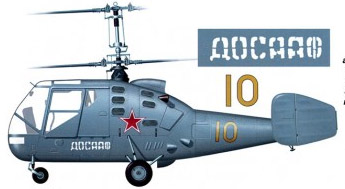 They had for the first time a single anti-submarine helicopter Ka-15 (NATO “Hen”). A landing pad for a Ka-15 helicopter was located at the stern with fuel supply enough for five flights. In addition, there were appropriate living quarters for the pilots and technical maintenance personnel. Therefore, the ships of Project 57 bis were the first Soviet ships with standard resident helicopters.
They had for the first time a single anti-submarine helicopter Ka-15 (NATO “Hen”). A landing pad for a Ka-15 helicopter was located at the stern with fuel supply enough for five flights. In addition, there were appropriate living quarters for the pilots and technical maintenance personnel. Therefore, the ships of Project 57 bis were the first Soviet ships with standard resident helicopters.
KA-15 Specs: 1 pilot + 1 pass. or 250 kg (551 lb) cargo. Length 6.26 m (20 ft 6 in), height 3.35 m (11 ft) rotor 9.96 m (32 ft 8 in) diameter, Empty weight 990 kg (2,183 lb) Max TO weight 1,410 kg (3,109 lb), One Ivchenko AI-14V 9-cyl. air-cooled radial piston engine 190 kW (250 hp). Top speed 150 km/h (93 mph, 81 kn) cruise 125 km/h (78 mph, 67 kn), range 390 km (240 mi, 210 nmi) ceiling 3,000 m (9,800 ft). Could be armed with two depht charges.
At the end of their carrer, they swapped the KA-15 used for observation, and no longer required after modernization, for the KA-25 in the 1980s, used in ASW patrol.

Old author’s illustration
⚙ Project 57-bis (Krupny) specifications |
|
| Displacement | 3500t standard, 4192t FL |
| Dimensions | 138.9 x 14.84 x 4.20-4.47 m () |
| Propulsion | 2 shafts TV-8 turbines, 4 boilers, 85,000 hp. |
| Speed | 34.5 knots max |
| Range | 3,060 nm at 18 knots |
| Armament | 2x SSN-1 SSM (16), 4×4 45mm AA, 2×5 533 mm TTs, 2x RBU-2500, helideck |
| Sensors | 310 Electronics Head Net Radars, Zalph Schch Fire Control, Neptun Navigation System, Sonar Pegas-2b. |
| Crew | 284 |
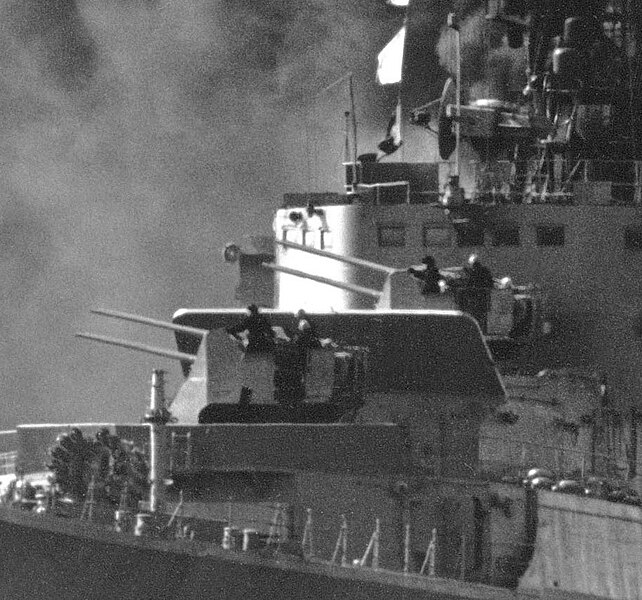
ZiF-75 of Gremyashchiy 1983 azfter her Pr.57A conversion;
The modernization of the ships (by this time almost all of them had been reclassified into DBK) of Project 57-B according to Project 57-A took place in 1960-1970. The reason for this was the extremely low efficiency and reliability of KSShch missiles. The ships of Project 57A, were so heavily modified they received the new NATO code designation of “Kanin”.
Instead of the SSM complex, they received the short-range anti-aircraft missile systems SAM “Volna” as well as new rocket launchers and torpedo tubes.
As a result of these changes, total displacement was raised by 300 tons, and they were reclassified as “large missile ships”.
Artillery systems:
-Two four-barreled 57-mm ZIF-75 AA guns instead of four.
-Four 30-mm twin AK-230 AA guns coupled with the MP-104 “Lynx” fire control radar.
Anti-aircraft missile system:
One anti-aircraft missile launcher of the Volna air defense system (for 32 missiles) with a Yatagan guidance station;
Torpedoes:
Two five-tubes torpedo of the new TA-53-1134 type, same location.
Anti-submarine weapons:
Three RBU-6000 rocket launchers (for RSL-60 projectile);
Radars, FCS:
Combat information and control system (CIUS) “Tablet-57”;
Surface target detection radar “Don” – 2 sets;
General detection radar MR-310A “Angara-M”;
MP-105 “Turel” artillery fire control radar;
MP-104 “Lynx” artillery fire control radar;
For the sonars, they used the MG-332 and MG-26 for active/passive detection. The sonar saw the addition of thermal detectors MI-110K and MI-110R. They received also the RTR MRP 11-14 “Zaliv” and electronic warfare equipment “Crab 11-12”;
In 1976-1977, at the Zhguchiy BOD, specialists from the Moscow Research Institute of Geochemical Research carried out tests of a new development – equipment for searching submarines using radioactive traces KOLOS-MN, KOLOS-75 and KOLOS-2000;
One Ka-25 anti-submarine helicopter (NATO “Hormone”).
⚙ Project 57A (Kildin) specifications |
|
| Displacement | 3700-4500t FL |
| Dimensions | 140.6* x 14.84 x 4.80 m* |
| Propulsion | Same |
| Speed | Same |
| Range | Same |
| Armament | 1×2 M-1 Volna SAM (32), same, 2×1 45mm/69 21KM, 4×2 30mm/71 AK-230, same, 3x 12 RBU-6000, helideck |
| Sensors | MR-310 Angara-A, 2x Volga, Yatagan, Fut-B, 2x MR-104 Rys, MG-312 Titan, MGS-407K sonars, see notes |
| Crew | 297 |
Construction
All Project 57 ships were laid down at three naval yards:
-Plant No. 190 Shipyard Zhdanov (St. Petersburg): 4 ships
-Plant No. 199 Shipyard Leninsky Komsomol (Komsomolsk-on-Amur): One ship (2 laid down, one converted)
-Plant No. 445 Shipyard 61 Kommunara (Nikolaev): 3 ships.
“Brave” (Bravyy): The ninth ship of the series was removed from construction on July 1, 1963 and mothballed. On January 25, 1969, the Brave was reorganized into the energy vessel ENS-73.
On March 11, 1982, the ship was handed over to VtorCherMet for dismantling, but then its hull was installed on a sandbank in Bezymyannaya Bay and was used as a target[7].
Read More/Src
Books
Apalkov Yu. V. Destroyers of projects 56, 57 bis and their modifications. – St. Petersburg: Morkniga, 2009.
Vasiliev A.M. et al. SPKB. 60 years with the fleet. – St. Petersburg: History of the ship, 2006.
Kuzin V.P., Nikolsky V.I. USSR Navy 1945-1991. – St. Petersburg: Historical Maritime Society, 1996.
Platonov A.V. Soviet destroyers. – St. Petersburg: Galeya-Print, 2003. T2.
Apalkov Yu. V. Ships of the USSR Navy. Directory in 4 volumes. – St. Petersburg: Galeya Print, 2003. – Vol. II, part I. Aircraft-carrying ships. Rocket and artillery ships
Apalkov Yu. V. Anti-submarine ships. – Morkbook. – M., 2010.
Kovalenko V. A., Ostroumov M. N. Handbook on foreign fleets. – M.: Military Publishing House, 1971.
Sokolov A. N. Fleet consumables. Destroyers of the USSR and Russia. – M.: Military Book, 2007.
Conway’s All the World’s Fighting Ships, 1947-1995. – NIP
Links
https://en.wikipedia.org/wiki/Kanin-class_destroyer
http://www.navweaps.com/Weapons/WTRussian_post-WWII.php
http://www.navweaps.com/Weapons/WNRussian_57mm-81_zif-71.php
https://www.navypedia.org/ships/russia/ru_dd_gnevnyy60.htm
https://web.archive.org/web/20120207203150/http://flot.sevastopol.info/ship/rocketship/bedoviy.htm
http://www.militaryrussia.ru/blog/index-1024.html
https://ru.wikipedia.org/wiki/%D0%AD%D1%81%D0%BA%D0%B0%D0%B4%D1%80%D0%B5%D0%BD%D0%BD%D1%8B%D0%B5_%D0%BC%D0%B8%D0%BD%D0%BE%D0%BD%D0%BE%D1%81%D1%86%D1%8B_%D0%BF%D1%80%D0%BE%D0%B5%D0%BA%D1%82%D0%B0_57-%D0%B1%D0%B8%D1%81
Videos
Model Kits
3D
 Gnevny (1958)
Gnevny (1958)

On November 16, 1957, under serial number 1401, “Gnevny” was laid down at Nikolaev Shipyard (61 Communard) by December 17, 1957, launched on November 30, 1958 and commissioned on January 10, 1960, by August 22 she was accepted to serve after completion of all qualifications, assigned to the Black Sea Fleet.
In 1961, she made a very long passage from the Black Sea, around Europe, then via Northern Sea Route to her new base of the Pacific Fleet. On May 19, 1966, Gnevny as all 57-bis project vessels was reclassified as “Large Rocket Ship”. She visited Massawa, Ethiopia twice (January 1967, 1969) and Casablanca, Morocco (October 1968, April 1978) and Aden, South Yemen in January 1969 but also Nairobi, Mauritius by April 1969, Bombay in November 1975, Vancouver by August 1976. Her only combat sortie was on behalf and in support of Egypt in June 1967 and from April to December 1968, but another off Syria as well by June 1967.
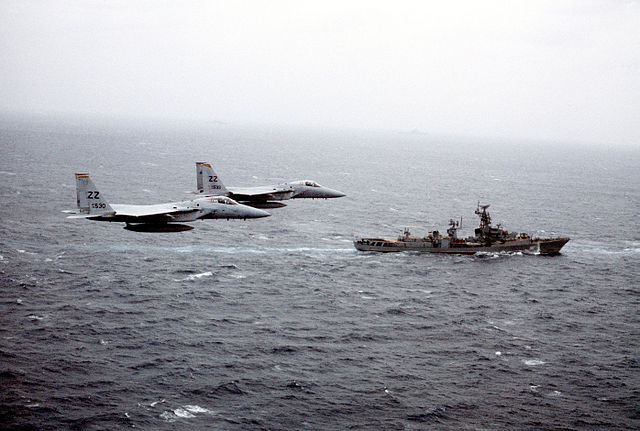
Gnevny flew over by F-15Ds in 1984
On March 13, 1969, Gnevny arrived at the Pacific Fleet and from 1972 to 1973, she was completely modernized as a Project 57-A vessel in Vladivostok, Dalzavod Shipyard. By March 7, 1974, she was reclassified as Large Anti-Submarine Ship. No record or even until she was decommissoned by April 8, 1988, disarmed and stricken, sold for BY on July 17.
 Gremyashchy (1959)
Gremyashchy (1959)

On December 17, 1958, Gremyashchy (“Thundering”) was was ordered, laid down on February 25, 1958, under serial number 771, at Leningrad as project 57, then revised and completed as project 57-bis, launched on April 30, 1959 and commissioned on June 30, 1960, accepted and assigned on December 19 to the Northern Fleet.
On July 6, 1962, during Northern Fleet exercises, four minutes after leaving Mogilnaya Bay, Kildinsky Roadstead, she rammed Project 30-bis destroyer Stremitelny while in heavy fog. Her flank was mushed and penetrated along 6 side plates, breaking cables and ruptured fuel lines, causing a fire. She also had a bended right shaft. The boiler No. 4 was completely destroyed, as well as its auxiliary systems and on killed sailor. Both the commander and navigator of Gremyashchy as well as the aboard commander of the 120th brigade were found guilty and removed from office but nothing was found in the actions of the commander and crew of the Stremitelny (‘Swift’).

Gremyashchy weapons details, as a Kanin class ship, 1983 (cropped of the above)
From 1966 to January 29, 1968 Gremyashchy was modernized at Zhdanov as a project 57A ship and reclassified. By May 14 to May 27 1970, she staye din Cuba, and by 1971 visited Norway and the Netherlands, and carried a war zone combat missions assisting the Egyptian armed forces in their 1973 fight against Israel.
On July 7, 1987, Gremyashchiy was decommissioned, disarmed but converted as experimental vessel and by August 25, 1988, renamed OS-315. By October 2, 1991 she was stricken and sold. In 1994, she was broken up by an Indian company.
 Uporny (1959)
Uporny (1959)
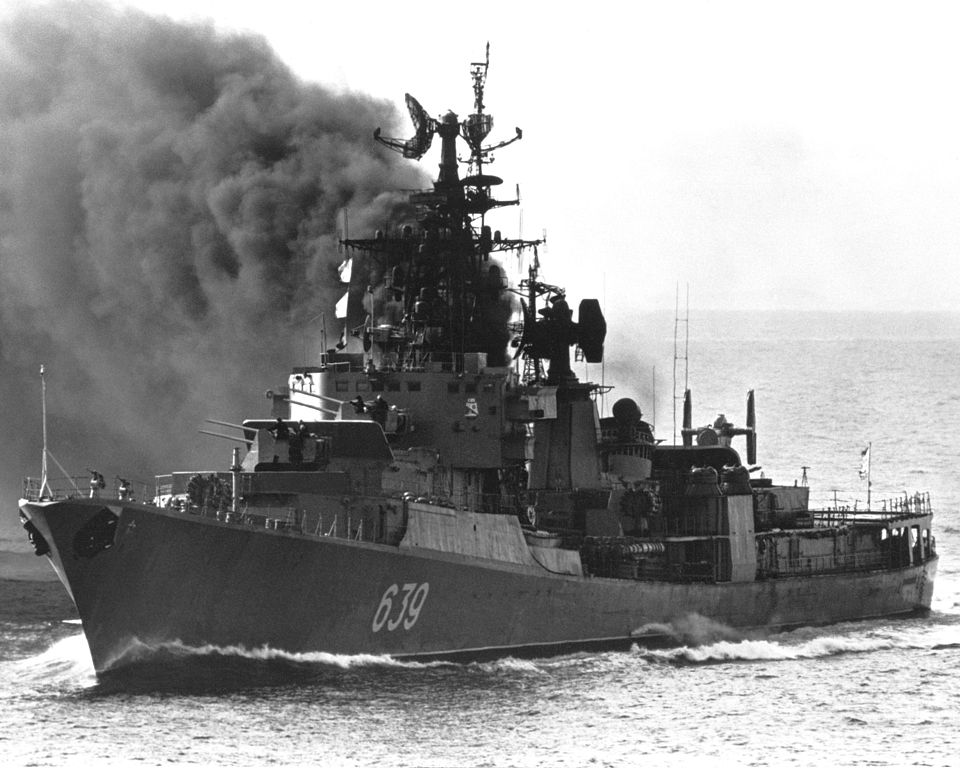
On April 9, 1958, “Uporny” was ordered, laid down on September 21, 1958, at Nikolaev shipyard under N°1402, project 57 bis, launched October 14, 1959 and commissioned by December 3, 1960. In June 1961, she transited from Sevastopol along the Northern Sea Route to Vladivostok, Pacific Fleet. From December 26, 1967 to March 22, 1968, she had an overhaul at Dalzavod, and by 1969, she had her first combat service mission in the Indian Ocean, stopping at Zanzibar, Tanzania, Male, Maldives and Umm Qasr in Iraq, as well as Bandar Abbas in Iran and Berbera in Somalia. From April 25, 1970 to August 19, 1970, she took part in fleet exercize in the Indian Ocean also visiting Mogadishu and Bombay. By August-October 1972 she had exercizes in the Pacific but also ventured to Canada, North America and Hawaii. From February 7, 1977 to February 3, 1978, Uporny was modernized and rebuilt at Dalzavod under project 57A. By June 24, 1991, she was decommissioned and used as the floating barracks PKZ-12. On June 29, 1993, she was stricken and sold by September 7, 1995, to a US shipbreaker.
 Zhguchiy (1959)
Zhguchiy (1959)
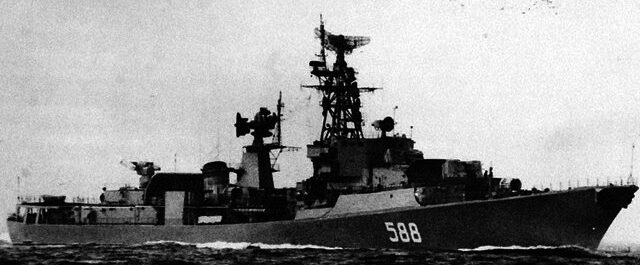
On April 9, 1958, Zhguchiy (“Burning”) was ordered, laid down on June 23, 1958, at Leningrad, Zhdanov yard under project 57, launched as Project 57-bis on October 14, 1959, completed on December 23, 1960. On January 3, 1961, she was assigned to the Northern Fleet and in 1965 and 1966, she won the prize of the Commander-in-Chief of the Navy for missile training. From February 6, 1967 to January 10, 1969, she was modernized under project 57-A at Zhdanov. From January 1 to December 31, 1970, she served in the Mediterranean, provided assistance to Egypt.
From September 10 to 15, 1971, she visited Oslo. In September 21-26, 1971, she visited Rotterdam and on May 12-17, 1975 visited Boston and later Cuba in May 24-29, 1977, visited Cherbourg and by October 10-15 Oslo again. From May 1980 to January 1981, she took part in exercises in the Atlantic and held a record for the longest sortie for her class. She indeed criss-crossed the Atlantic to Angola, Guinea, Benin and rescued Soviet and Cuban fishermen in the Western Sahara region. On July 30, 1987, she was decommissioned, stricken on August 6, 1987, sold by December 1988, to a Spanish company.
 Gordy (1960)
Gordy (1960)
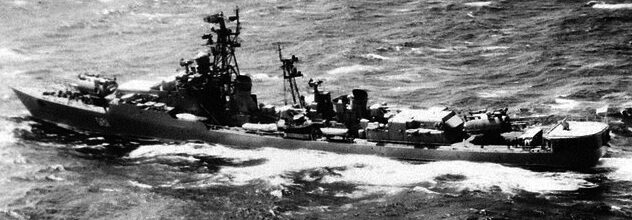
On December 17, 1957, Godry (“Proud”) was ordered and by May 1959 laid down at the Amur Shipbuilding Plant (Komsomolsk-on-Amur under n°90) as a project 57 bis destroyer. She was launched on May 24, 1960 and completed by February 6, 1961, accepted in the Pacific fleet on November 15, 1961. In 1967, she “confronted” USS Enterprise Carrier Battle Group, which “entered Soviet territorial waters”.

Gordy in the Pacific, 1968
The situation became tense with the arrival of agressivle, low-flying Soviet fighters, until the CBG regained internaitonal waters. From March 28 to 31, 1968, she visited Madras and in April 3-6 she was in to Bombay, training also with the Indian Fleet.
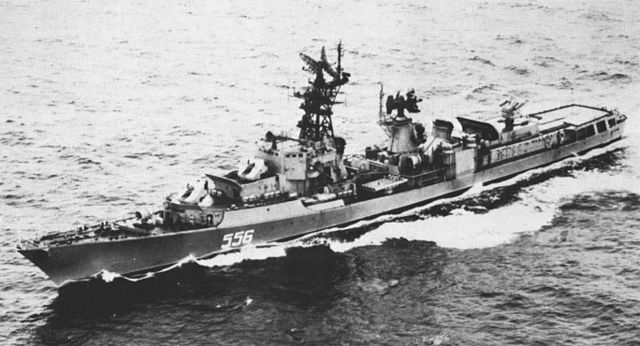
Gordy as a Kanin class DD in 1984
From 1973 to 1975, she was modernized at Dalzavod as project 57-A Kanin. On July 30, 1987 she was decommissioned, placed on disposal but not sold as instead on August 9, 1987, she was sunk as target ship in the Bering Sea off the coast of Kamchatka by missiles.
 Boiky (1959)
Boiky (1959)
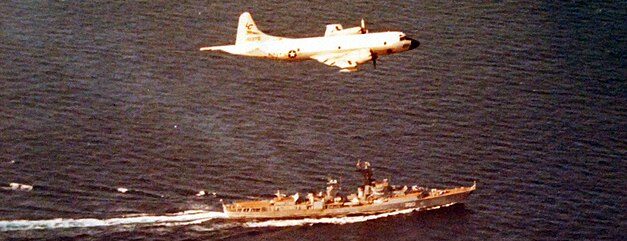
Boiky underway flew over by a USN P3 Orion, 1970s
Ordered on July 8, 1959, Boykiy wa slaid down on April 2, 1959, at Nikolaev Shipyard No. 445 (N°1403) as project 57 bis destroyer, launched on December 15, 1959 commissioned on June 26, 1961 and accepted by October 14, 1961 in the Black Sea Fleet. In August 6-11, 1966, she visited Alexandria and on February 15-20, 1969, Conakry (Guinea), on October 5-10, Lagos (Nigeria).
On June 8, 1970, she was transferred to the Red Banner Northern Fleet. Between October 23, 1970 and April 6, 1973, she was rebuilt and modernized as a project 57-A at 61 Communard Shipyard, Nikolaev. On November 12-17, 1974, together with her sister Zorkiy, flagship, squadron commander with a support ship, she visited Oslo and by May 12-17, 1975, wuth her sister Zhguchiy she visited Boston.
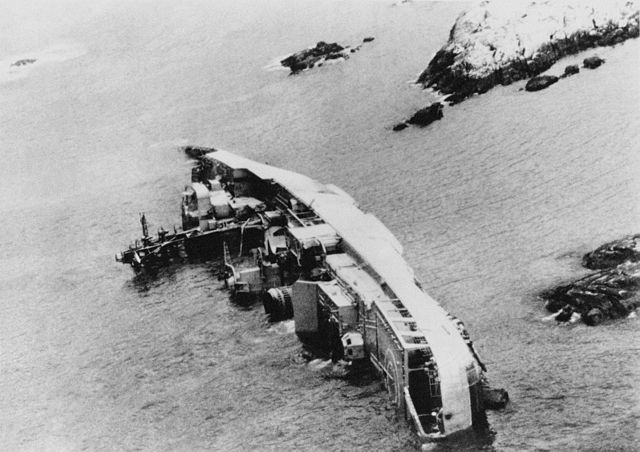
Boiki capsized at Skogsøya, en route to El Ferrol in November 1988. She was broken up in situ.
In 1983, Boikiy took part in nuclear weapons tests at Novaya Zemlya, Matochkin Shar Strait. In 1984, Boiky tested the effect of theermonuclear blast on a ship, evacuated by her crew with the exception of the special purpose emergency rescue group, Veterans of special risk units. Due to the effects of the blast she was towed to safety and not used again. She was decommissioned by February 9, 1988, stricken July 17, 1988, and sold by the fall of 1988 to a Spanish company at El Ferrol, to be BU. Unfortunately while under tow, she was hit on November 14, 1988 by a strong storm and washed up on coastal rocks near Skogsøya, Norwegian Sea. She was later blasted and BU on site, the remains still explored by divers.
 Zorkiy (1960)
Zorkiy (1960)

Zorkiy was ordered on April 9, 1958, laid down on April 17, 1959 at Zhdanov yard as project 57 bis ship, launched on April 30, 1960, commissioned on September 30, 1961.
On October 14, 1961 she was accepted in the Baltic Fleet and on 1966, won the prize of the Commander-in-Chief for missile training. Between May 29, 1969 and December 31, 1971, she was modernized as a Project 57-A ship. Between December 1972 and February 1973, she visited Cuba for a state visit.
By November 12-17, 1974, she visited Oslo and on 12-17 April 1979 Bissau (Guinea-Bissau). From February 10, 1984 to February 17, 1987, she had major overhaul at shipyard No. 35, Murmansk.
On June 1, 1992, she was reclassified as a patrol ship and decommissioned by June 30, 1993, stricken December 31, sold on July 18, 1995, to a US company and BU.
 Derzkiy (1960)
Derzkiy (1960)
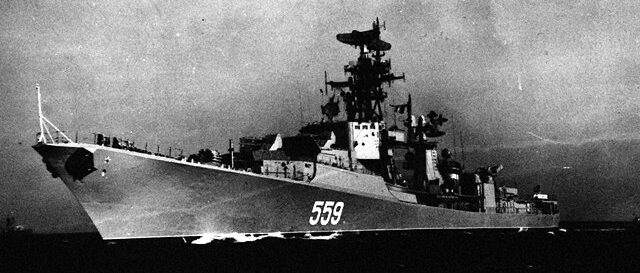
Ordered on April 9, 1958, Derzkiy (“Daring”) was laid down on October 10, 1959, at Leningrad Zhdanov Yard as project 57 bis ship, launched February 4, 1960, commissoned by December 30, 1961.
On January 12, 1962 she was accepted in the Northern Fleet. From February 6, 1967 to January 10, 1969, she was converted as a Project 57-A Kildin class destroyer at Zhdanov. On August 4-9, 1973, she visited Havana. She was decommissioned by August 7, 1977, mothballed, laid up in Sayda Bay. On April 19, 1990, she was stricken and later turned into a target ship, expected sunk by now (2024).


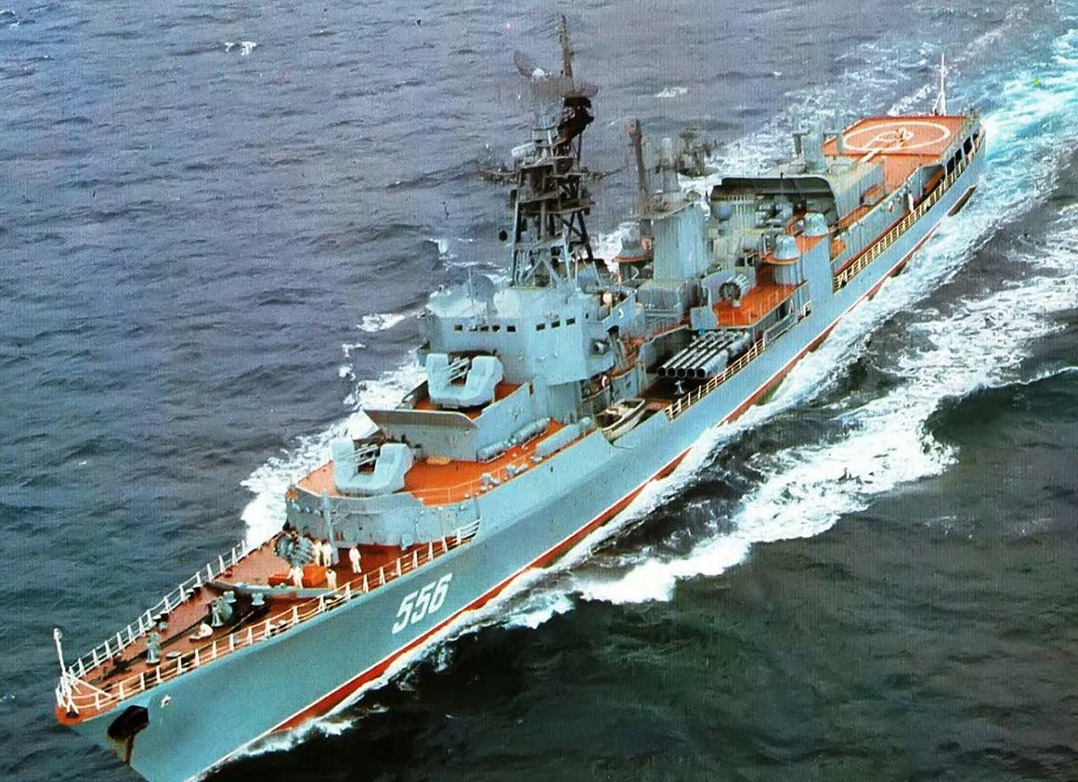
 Latest Facebook Entry -
Latest Facebook Entry -  X(Tweeter) Naval Encyclopedia's deck archive
X(Tweeter) Naval Encyclopedia's deck archive Instagram (@navalencyc)
Instagram (@navalencyc)





 French Navy
French Navy Royal Navy
Royal Navy Russian Navy
Russian Navy Armada Espanola
Armada Espanola Austrian Navy
Austrian Navy K.u.K. Kriegsmarine
K.u.K. Kriegsmarine Dansk Marine
Dansk Marine Nautiko Hellenon
Nautiko Hellenon Koninklije Marine 1870
Koninklije Marine 1870 Marinha do Brasil
Marinha do Brasil Osmanlı Donanması
Osmanlı Donanması Marina Do Peru
Marina Do Peru Marinha do Portugal
Marinha do Portugal Regia Marina 1870
Regia Marina 1870 Nihhon Kaigun 1870
Nihhon Kaigun 1870 Preußische Marine 1870
Preußische Marine 1870 Russkiy Flot 1870
Russkiy Flot 1870 Svenska marinen
Svenska marinen Søværnet
Søværnet Union Navy
Union Navy Confederate Navy
Confederate Navy Armada de Argentina
Armada de Argentina Imperial Chinese Navy
Imperial Chinese Navy Marinha do Portugal
Marinha do Portugal Mexico
Mexico Kaiserliche Marine
Kaiserliche Marine 1898 US Navy
1898 US Navy Sovietskiy Flot
Sovietskiy Flot Royal Canadian Navy
Royal Canadian Navy Royal Australian Navy
Royal Australian Navy RNZN Fleet
RNZN Fleet Chinese Navy 1937
Chinese Navy 1937 Kriegsmarine
Kriegsmarine Chilean Navy
Chilean Navy Danish Navy
Danish Navy Finnish Navy
Finnish Navy Hellenic Navy
Hellenic Navy Polish Navy
Polish Navy Romanian Navy
Romanian Navy Turkish Navy
Turkish Navy Royal Yugoslav Navy
Royal Yugoslav Navy Royal Thai Navy
Royal Thai Navy Minor Navies
Minor Navies Albania
Albania Austria
Austria Belgium
Belgium Columbia
Columbia Costa Rica
Costa Rica Cuba
Cuba Czechoslovakia
Czechoslovakia Dominican Republic
Dominican Republic Haiti
Haiti Hungary
Hungary Honduras
Honduras Estonia
Estonia Iceland
Iceland Eire
Eire Equador
Equador Iran
Iran Iraq
Iraq Latvia
Latvia Liberia
Liberia Lithuania
Lithuania Mandchukuo
Mandchukuo Morocco
Morocco Nicaragua
Nicaragua Persia
Persia San Salvador
San Salvador Sarawak
Sarawak Uruguay
Uruguay Venezuela
Venezuela Zanzibar
Zanzibar Warsaw Pact Navies
Warsaw Pact Navies Bulgaria
Bulgaria Hungary
Hungary

 Bundesmarine
Bundesmarine Dutch Navy
Dutch Navy Hellenic Navy
Hellenic Navy Marina Militare
Marina Militare Yugoslav Navy
Yugoslav Navy Chinese Navy
Chinese Navy Indian Navy
Indian Navy Indonesian Navy
Indonesian Navy JMSDF
JMSDF North Korean Navy
North Korean Navy Pakistani Navy
Pakistani Navy Philippines Navy
Philippines Navy ROKN
ROKN Rep. of Singapore Navy
Rep. of Singapore Navy Taiwanese Navy
Taiwanese Navy IDF Navy
IDF Navy Saudi Navy
Saudi Navy Royal New Zealand Navy
Royal New Zealand Navy Egyptian Navy
Egyptian Navy South African Navy
South African Navy






























 Ukrainian Navy
Ukrainian Navy dbodesign
dbodesign